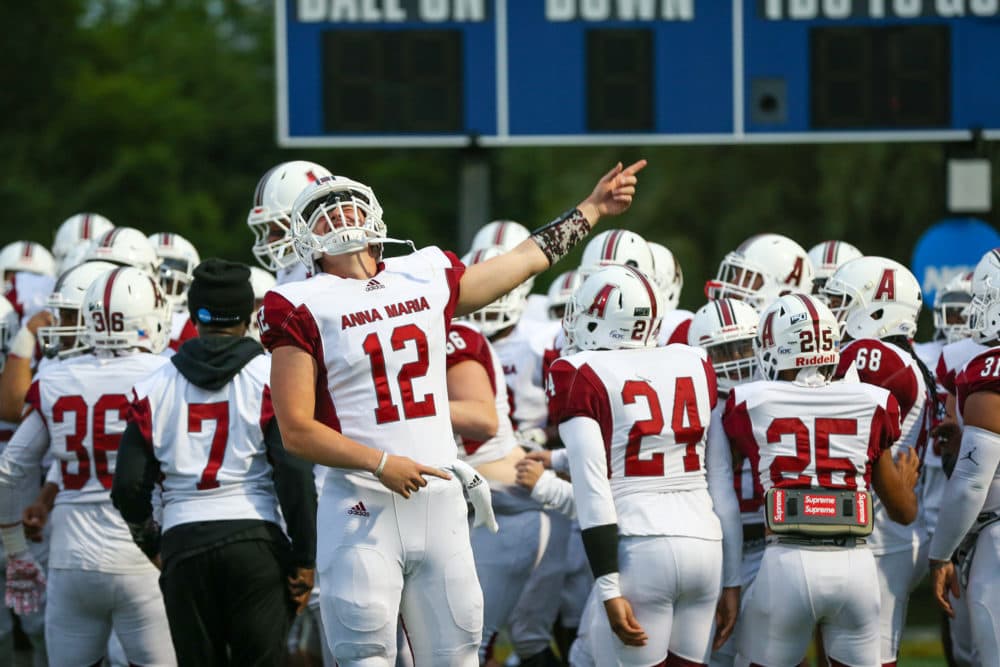Advertisement
How Some Colleges Benefit From Adding (Or Dropping) Football

With growing awareness about the connection between football and head injuries, youth and high school participation in the sport has declined in recent years.
But at the college level, things have gone a bit differently. New York Times reporter Bill Pennington recently wrote about what’s actually happening in college football.
KG: So with all the focus on concussions and all the news reports of football losing ground at the high school level, I think our listeners might have the impression that colleges must be backing away from the sport at this point. But overall, that's not what's happening, right?
BP: That's correct. And it's a sort of popular perception that it's in decline everywhere. But that's really not so. There are schools and institutions that are dropping the sport — about 23 in the last 10 years. I'm sure there will be more — perhaps many more. But in that same 10-year period, 66 institutions have added college football and seven more are planning to next year.
It's sort of the dichotomy that's going on about this sport in America. There are people that see it as a danger — and this includes colleges — that see it as a danger or an unwanted headache. And there are schools that see it as a panacea for all kinds of things.
KG: All right. So, to prove this point, you compared two schools. Both of them are in Massachusetts: Northeastern University in Boston and Anna Maria College — about 60 miles to the west, near Worcester. How did you come up with that idea? Because, frankly, I'm a bit surprised that someone with The New York Times has even heard of Anna Maria.
BP: Well, I have heard of Anna Maria. I am from northern Connecticut. So maybe I'm just a little more versed in what's going on around in Worcester area. Look: We looked at the list of schools that had dropped [football] and the list that had added. Granted, most of the ones that have added, but not all, are smaller colleges. So Anna Maria fit that, you know, as a prototype.
The other school we chose was Northeastern, which fit the prototype for dropping. Granted, they're two very different kinds of institutions in size and in the kinds of students that they attract. That's part of the story, too — is that football means different things in different places.
KG: Let's start with the school that dropped football. That was Northeastern. And this is how their decision was reported on this very program back in November of 2009.
On Monday, the football program at Northeastern University in Boston was thrown for the ultimate loss, when athletics director Peter Roby announced the elimination of the sport. Northeastern hadn't had a winning season since 2004, but lots of college football teams lose more often than they win. Northeastern's problem, according to Roby, was money.
"It was clear that in order for us to compete at a level that we wanted to against the programs that we have to play against in the Colonial Athletic Association, it was going to require investments in the multiples of millions of dollars," Peter Roby said. "And I just didn't feel I could make that recommendation to the senior leadership of the institution."
KG: You also spoke with Peter Roby. What did he tell you about how he delivered that news and how it was received?
BP: I think he had given a lot of forethought to it. The university had planned for this moment for a few months, it seemed like. They understood that they were abandoning — for lack of a better word — about 70 football players who thought that they were going to continue to play, that had been brought to the university to play football, that this was gonna be really rough news for them and for their families, for their coaches.
So, Peter Roby told me about that. And he went into it knowing probably what was going to happen was that you can have all the forethought you want, but people are gonna be devastated in that room when you're delivering that news to that group. And that's exactly what happened. And so, there was players crying, sobbing, cursing, cursing at him. So it was a very emotional meeting, as it always is, when a sport is dropped, especially one that sort of has the prominence of football.
KG: So, how has that decision turned out for Northeastern? Has the school suffered horribly for having gotten rid of football?
BP: No, quite the opposite. It seems to be hardly missed. Applications have more than doubled. Research funding has nearly tripled. In just about all the sort of obvious ways, Northeastern has had a great 10 years since it dropped football. Now, I don't think anybody there really says it's because we dropped football. But it's interesting that it has certainly not held them back.

KG: Around the same time that Northeastern decided to eliminate its football program, Anna Maria added the sport. Can you describe Anna Maria College for me? Because all the photos that accompany your article make it look like it's in the middle of the woods.
BP: Well, it is a little bit. It's more of a suburb, I guess, but it is up on a hill. You know, there's not much around there. It's a small campus — 190 acres. It's very sort of peaceful, tranquil. It's like a lot of small colleges you'd see in New England. It was a former all-girls school. And it went co-ed in the early 70s. But it's a nice, bucolic, private little place.
KG: So 10 years ago, when Anna Maria made this decision to add football, what were they hoping it would do?
BP: The goal — and, you know, I actually wrote a story about schools like this adding football 15 years ago — the reasons then are the same as they are now: it increases the number of male applicants, just because you get 100 admitted. So that — for a school with an enrollment of, at the time, 750, 800 — that's a big boost. A football team tends to attract other male applicants, even if they don't plan on playing football. They want to go to a school where there is a football team. The school was about 70% female at the time, so now they have better gender balance in that sense. So they get that.
It's also true — and this may be the most important part, at least in terms of understanding this phenomenon — nobody's on scholarship at Anna Maria. This is a Division III school where athletic scholarships are prohibited in all sports. And so these players are paying their way — maybe not the entire cost — but I was told that the average football player's paying about $20,000 a year to attend the school.
Advertisement
You know, do the math. I mean, 100 or 110 players times $20,000 — that's quite a bit of revenue. And this is going on all over America. There are a lot of young men out there who are finishing up their high school football careers and don't want to stop playing. They're not good enough to go play Division I, but they are good enough to contribute on the Division III level. And here's a chance for them to keep playing.

KG: So, while a Division I school like Northeastern can save a whole lot of money by getting rid of their football program, a school like Anna Maria can make a lot of money.
BP: Correct. Absolutely. And, because there's no athletic scholarships, because the coaches are not coaches, maybe, that have built up the experience where they're gonna earn a salary of, you know, several hundred thousand dollars or millions, you don't need eight trainers, you don't need chartered jets to get you around to games, and so the costs are very low. It's a revenue boost for these schools. Absolutely.
KG: I've been making a lot of jokes about nobody knowing about Anna Maria College, but actually my husband went there and taught there for a while. And it's a place that he's told me where there's really just not anything to do. You're outside of Worcester, but it's not easy to get to downtown. You're kind of in the middle of nowhere.
BP: Yeah. I mean, there's a lot of schools like that in America. You know, if the basketball team is really good, people will come to the basketball games. If the hockey team is really good, they will come to the hockey games. But if they're just mediocre, then nobody will come to the games.
And football, I mean, they haven't had a winning team. They've had 11 successive losing seasons, and people still come to the games. And there's still sort of a buzz on campus that weekend. And alumni come out and tailgate before the game and after the game. You know, that's part of why these schools are adding football. It just creates a different vibe. And for those kinds of schools and certain of them — and there's many of them — this is exactly what they're seeking.
KG: We've talked a little about how Anna Maria is representative of the schools that are adding football. Let's talk about why Northeastern is representative of the schools that are getting rid of it. Are they mostly schools that are in urban areas, that are potentially Division I, that have more expensive programs and that have — I don't know — communities that have other things to focus on?
BP: Generally. Often what it comes down to is: they're not winning a lot, it's not, like, an integral part of the university's culture. It's very different at the University of Michigan, let's say, where it is, or Notre Dame or Alabama or dozens and dozens of other Division I schools where it's an integral part of that fall culture.
And, I'd be interested to see if, in the future, more of the decisions are based on things like, "We don't want to be associated with a game where there seems to be a danger to your brain." There aren't many schools that have said we're dropping the program because, you know, we have a problem with the sport in general.
This segment aired on January 11, 2020.
